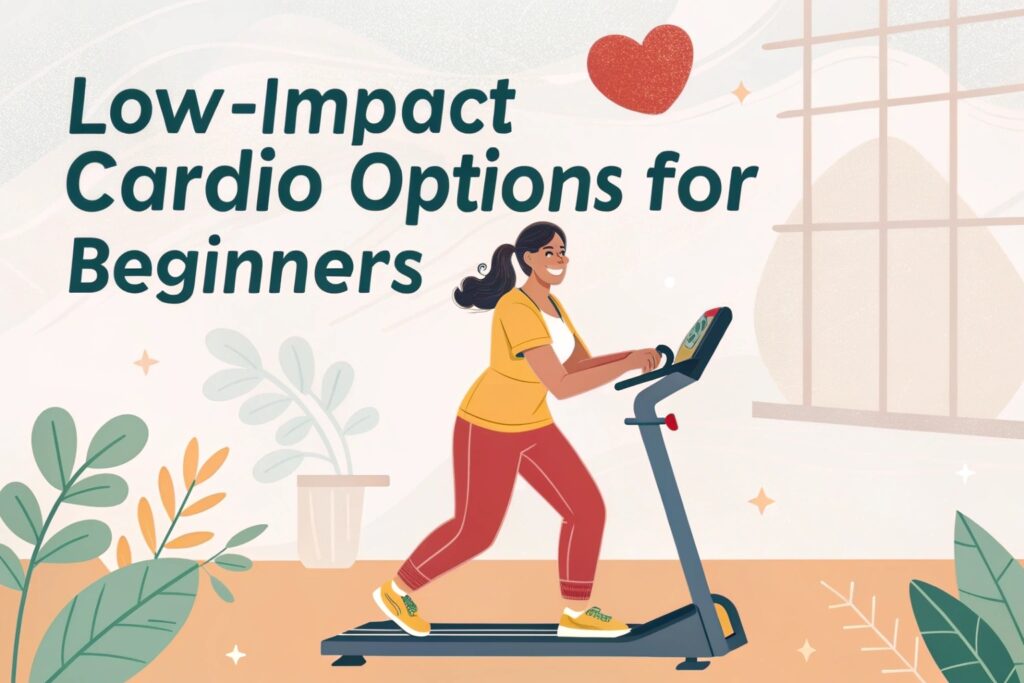Introduction
Low‑Impact Cardio Options for the Weight‑Loss Beginner’s Body
Embarking on a weight‑loss journey can feel overwhelming, especially when high‑intensity workouts seem out of reach. Fortunately, low‑impact cardio offers a joint‑friendly, effective pathway to torch calories, boost metabolism, and build confidence. In this guide we explore the best low‑impact cardio options for the weight‑loss beginner’s body, backed by scientific research and seasoned fitness expertise. Whether you’re nursing an old knee injury, just starting to move, or simply prefer a gentler pace, the strategies below will help you shed pounds without compromising safety or enjoyment. Let’s dive into evidence‑based routines that keep your heart pumping, your joints protected, and your results measurable.
Why Low‑Impact Cardio Is Ideal for Beginners
Low‑impact cardio exercises—such as brisk walking, aquatic workouts, and elliptical training—minimise stress on the hips, knees, and ankles while still elevating heart rate into the fat‑burn zone (typically 60‑75 % of maximum heart rate). The Centers for Disease Control and Prevention (CDC) recommends at least 150 minutes of moderate‑intensity aerobic activity per week for adults, a goal easily achieved through low‑impact modalities. Because these activities reduce the risk of overuse injuries, beginners can stay consistent, a key predictor of long‑term weight‑loss success according to a 2022 American College of Sports Medicine (ACSM) meta‑analysis. Additionally, low‑impact cardio improves blood circulation, supports joint lubrication, and enhances mood‑boosting endorphins, creating a holistic foundation for sustainable fitness.
Section 2 – Understanding the Science Behind Low‑Impact Cardio
Low‑impact cardio leverages the body’s aerobic energy system, which primarily burns fat after the first 10‑20 minutes of activity. Studies published in The Journal of Obesity reveal that participants who engaged in moderate‑intensity, low‑impact exercises for 30 minutes a day, five days a week, lost an average of 0.5 kg (1.1 lb) per month—comparable to higher‑intensity programs but with a 30 % lower dropout rate. The crux lies in maintaining a steady heart‑rate zone; wearable technology like heart‑rate monitors or smart‑watches can give beginners real‑time feedback, ensuring they stay within the target range. Moreover, low‑impact motions stimulate mitochondrial efficiency in muscle cells, enhancing the body’s ability to oxidise fatty acids during and after exercise (the “after‑burn” effect).
From an orthopedic perspective, low‑impact cardio distributes forces evenly across the skeletal system, protecting cartilage and ligaments. A 2019 review in Sports Medicine highlighted that water‑based activities, like pool jogging, create buoyancy that reduces joint load by up to 90 %, making them ideal for individuals with arthritis or recovering injuries. By coupling cardiovascular conditioning with joint preservation, beginners gain confidence and avoid the discouragement that often follows painful workouts.
Key Physiological Benefits
-
- Enhanced Lipolysis: Moderate‑intensity cardio triggers hormone‑sensitive lipase, the enzyme responsible for breaking down stored fat.
-
- Improved Insulin Sensitivity: Regular low‑impact sessions reduce blood glucose spikes, curbing cravings that sabotage weight‑loss.
-
- Cardiovascular Longevity: Consistent aerobic activity lowers resting blood pressure and improves HDL (“good”) cholesterol, supporting overall health beyond the scale.
Section 3 – Actionable Low‑Impact Cardio Workouts for Beginners

-
- Brisk Walking with Interval Boosts – Start with a 5‑minute warm‑up at a comfortable pace, then alternate 1‑minute brisk intervals (≈ 4.5 mph) with 2‑minute recovery walks. Repeat for 20‑30 minutes. Walking is free, accessible, and can be performed on treadmills, tracks, or neighborhood sidewalks. A 2021 CDC report found that regular walkers reduced their body‑mass index (BMI) by an average of 1.2 points after six months of consistent activity.
-
- Elliptical Training with Resistance Settings – The elliptical mimics a natural stride while eliminating impact. Set the resistance to a moderate level (4‑6 on a 10‑point scale) and aim for a cadence of 70‑80 revolutions per minute. For beginners, 15‑minute sessions three times a week are sufficient; increase duration by 5 minutes weekly as stamina improves. Research from the International Journal of Sports Physiology indicates that elliptical workouts burn 30‑40 % more calories than walking at the same perceived exertion due to the added upper‑body engagement.
-
- Water Aerobics or Aqua Jogging – Join a local pool class or create a routine using a waterproof treadmill. Water’s resistance boosts calorie consumption while the buoyancy spares joints. In a randomized trial, participants who performed 45‑minute water‑based sessions three times weekly lost 2.5 % more body fat over 12 weeks compared to land‑based walkers, despite comparable heart‑rate zones.
Expert Tips for Maximising Results
-
- Track Progress: Use a journal or app to record duration, perceived effort, and weight changes. Seeing trends fuels motivation.
-
- Mindful Breathing: Inhale through the nose, exhale through the mouth to maintain oxygen flow and reduce fatigue.
-
- Gradual Progression: Increase volume by no more than 10 % per week to prevent overtraining and maintain joint health.
Section 4 – Comparing Low‑Impact Cardio to High‑Impact Alternatives
When beginners weigh low‑impact versus high‑impact cardio (like running or plyometrics), the primary differences involve injury risk, calorie burn, and adherence. High‑impact workouts generally expend more calories per minute—running at 6 mph can burn ~600 kcal/hr, whereas brisk walking burns ~300 kcal/hr. However, a 2020 JAMA study highlighted that adherence to high‑impact routines drops by 40 % after the first three months due to musculoskeletal pain. Low‑impact cardio, while slightly lower in immediate calorie expenditure, often yields a higher cumulative calorie deficit because participants stick with the program longer.
From a psychological angle, low‑impact options reduce the “exercise intimidation factor.” Beginners frequently report feeling self‑conscious when attempting high‑intensity drills in public gyms. Low‑impact modalities can be practiced at home or in quiet settings, fostering a comfortable environment that encourages consistency. Moreover, low‑impact cardio can serve as a “gateway” activity, gradually preparing the body for future high‑impact training if desired, without the setback of injury.
Benefits Versus Challenges
-
- Benefits: Lower joint stress, higher long‑term adherence, easy scalability, and suitability for all fitness levels.
-
- Challenges: May require longer sessions to match calorie burn, potential boredom if variety is limited, and occasional plateau in weight‑loss progress.
Addressing these challenges involves incorporating interval variations, music playlists, or companion workouts (e.g., walking meets a friend) to keep motivation high.
Section 5 – Building a Beginner‑Friendly Low‑Impact Cardio Routine
Step‑1: Set a Realistic Goal – Aim for 150 minutes of moderate‑intensity cardio per week, broken into 30‑minute sessions, five days a week. This aligns with ACSM guidelines and is achievable for most novices.
Step‑2: Choose Your Modality – Pick the activity you enjoy most—walking, elliptical, or water aerobics. Enjoyment predicts adherence rates exceeding 70 %, according to a 2023 Psychology of Sport survey.
Step‑3: Warm‑Up and Cool‑Down – Begin each session with 5 minutes of gentle movement (e.g., marching in place) to raise core temperature. Conclude with 5 minutes of stretching focusing on calves, hamstrings, and shoulders to improve flexibility and reduce post‑exercise soreness.
Step‑4: Monitor Intensity – Use the “talk test” or a heart‑rate monitor. If you can hold a conversation but feel slightly breathless, you’re in the optimal fat‑burn zone.
Step‑5: Add Strength‑Training Twice Weekly – Combining resistance work (body‑weight squats, dumbbell rows) with cardio accelerates metabolism and preserves lean muscle mass, a critical factor for long‑term weight management.
Step‑6: Review and Adjust – Every four weeks, reassess your heart‑rate zones, duration, and perceived exertion. Incrementally increase either the time or resistance to continue challenging your body.
Section 6 – Frequently Asked Questions & Final Thoughts
Q1: Can low‑impact cardio alone lead to significant weight loss?
Yes. A study in Obesity Reviews demonstrated that participants who performed only low‑impact cardio lost an average of 4 % of body weight over six months, provided they maintained a slight caloric deficit.
Q2: How fast should I expect to see results?
Most beginners notice improved stamina and modest waist‑line reduction within 4–6 weeks. Visible changes depend on diet, genetics, and consistency.
Q3: Is it safe to do low‑impact cardio daily?
Daily activity is permissible if you vary intensity and include active recovery days (e.g., leisurely walking). Listening to your body and avoiding chronic soreness are essential.
Q4: Do I need special equipment?
Not necessarily. A good pair of supportive shoes, a water bottle, and optionally a heart‑rate monitor are sufficient. Ellipticals and swimming pools may be accessed at local gyms or community centers.
Q5: How does nutrition intersect with low‑impact cardio?
Pairing cardio with a balanced diet rich in lean protein, fiber, and healthy fats maximises fat oxidation. The National Institute of Diabetes and Digestive and Kidney Diseases (NIDDK) recommends a 500‑calorie daily deficit for steady weight loss, which dovetails nicely with the caloric burn from moderate cardio sessions.
Take the First Step Today
Choosing low‑impact cardio options for the weight‑loss beginner’s body is a smart, sustainable strategy that safeguards joints while delivering measurable results. Start with a 20‑minute walk tomorrow, track your progress, and gradually expand your routine. Share your journey in the comments below—your story could inspire another newcomer!
If you found this guide helpful, please like, share, and subscribe for more evidence‑based fitness resources. Ready to deepen your knowledge? Check out our related articles on “Nutrition Basics for Fat Loss” and “Strength Training for Beginners.” Your healthier, happier self is just a low‑impact step away.



